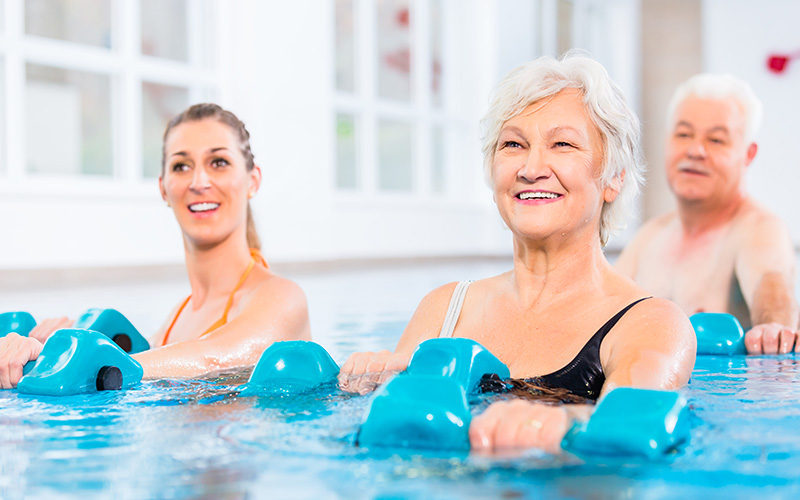
Does Aquatic or Water Based Physical Therapy Help With Fibromyalgia & Easing Pain?
It is well documented how aquatic therapy benefits many orthopaedic diagnosis, but not many know of the benefits it has for Fibromyalgia and Chronic Regional Pain Disorder (CRPS). The Mayo Clinic states that Fibromyalgia is a disorder characterized by widespread musculoskeletal pain accompanied by fatigue, sleep, memory and mood issues. Researchers believe that fibromyalgia amplifies painful sensations by affecting the way your brain processes pain signals. The Mayo Clinic describes Complex Regional Pain Syndrome (CRPS) as a form of chronic pain that usually affects an arm or a leg and the cause isn’t clearly understood. The pain is out of proportion to the severity of the initial injury. CRPS occurs in two types, with similar signs and symptoms, but different causes:
- Type 1: also known as Reflex Sympathetic Dystrophy Syndrome (RSD); this type occurs after an illness or injury that didn’t directly damage the nerves in your affected limb; about 90 percent of people with CRPS have type 1.
- Type 2: once referred to as Causalgia; this type has similar symptoms to Type 1, but Type 2 CRPS follows a distinct nerve injury.
Many causes of Fibromyalgia & CRPS are similar and may have orthopaedic involvement. CRPS may occur after a forceful trauma to an arm or a leg that can include a crushing injury, fracture or even just a surgery. Fibromyalgia symptoms may begin after a physical trauma, surgery, infection or gradually accumulate over time with no single triggering event.
Exercise, especially aquatic therapy, has been documented to help control symptoms with Fibromyalgia and CRPS. Gentle, guided exercising of the affected limbs might help decrease pain and improve range of motion and strength. At first, exercise may increase your pain, but doing it gradually and regularly often decreases symptoms. It is important to remember that moderation means not overdoing it on your good days, but also it means not self-limiting or doing too little on the days when symptoms flare.
Does Warm Water Exercise Ease Pain From Fibromyalgia?
Warm water at a therapeutic temperature (88-96 degrees) is a must for maximal benefit of aquatic therapy. Warm water relaxes muscles and allows for improved flexibility and joint range of motion (ROM), which helps with joint stiffness, muscle tightening, and improving functional mobility. Buoyancy is probably the largest benefit over land-based therapy because the deeper a body is immerse in water the less shock is transmitted through bones, ligaments, and joints. Here is a quick guide showing how much decreased force/demand occurs on joints when in water:
- water at waist level = 50% of weight through joints
- water at chest level = 75% of weight through joints
- in deep water = no weight through joints
With less demands/forces on the joints, more energy efficient movement can occur allowing improved joint mobility which contributes to dynamic flexibility. With the decreased forces on your body, patients are able to walk, squat, climb steps, strengthen their legs and core, and even jog, with little to no symptoms. Resistance is another huge benefit. It can allow you to improve your strength because even with simply just walking, you are walking against about 12 times the resistance of air. The resistance of water allows improvement in balance, sensory awareness, and strength in all muscle directions. The turbulence of the water and resistance during movements puts more demands on your balance and promote circulation. All these allow the patient to work what is tight and weak in a safe, comfortable environment.
What Are the Benefits of Aquatic Physical Therapy in Treating Fibromyalgia Pain?
- Patient ability to exercise in moderation to eventually return to normal function
- Less stress on joints while improving flexibility
- Decrease pain and improve range of motion
- Easing of other symptoms related to Fibromyalgia
All these benefits of aquatic therapy (therapeutic temperature, buoyancy, and the resistance of water) allow the patients can get a workout gently and with moderation and ultimately achieve the goals of therapy and returning to normal function even with complex diagnosis of Fibromyalgia and CRPS.
For More Information on the Benefits of Aquatic Physical Therapy in the San Diego Area, Contact One of Our Clinics:
Rancho Bernado Physical Therapy Clinic
Carlsbad Physical Therapy Clinic
Carmel Valley Physical Therapy Clinic

